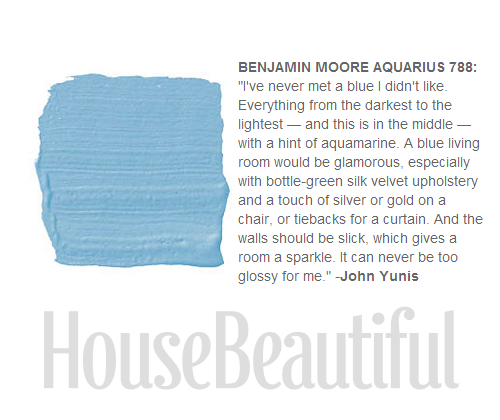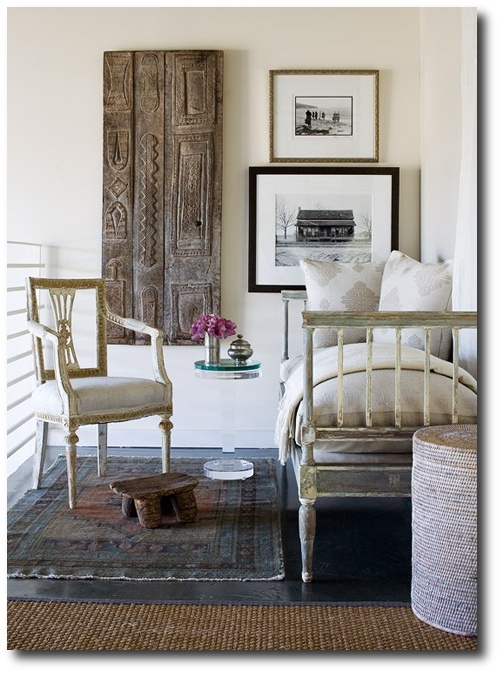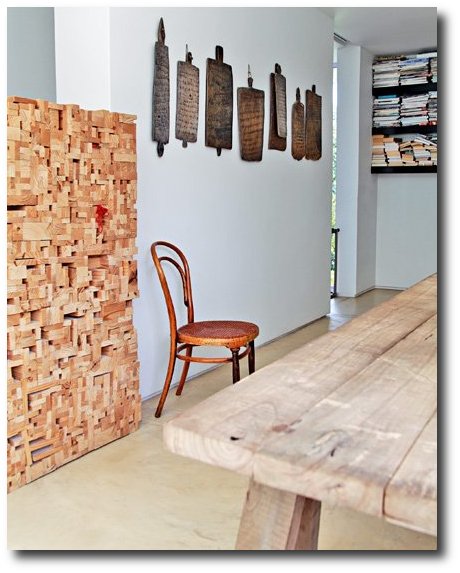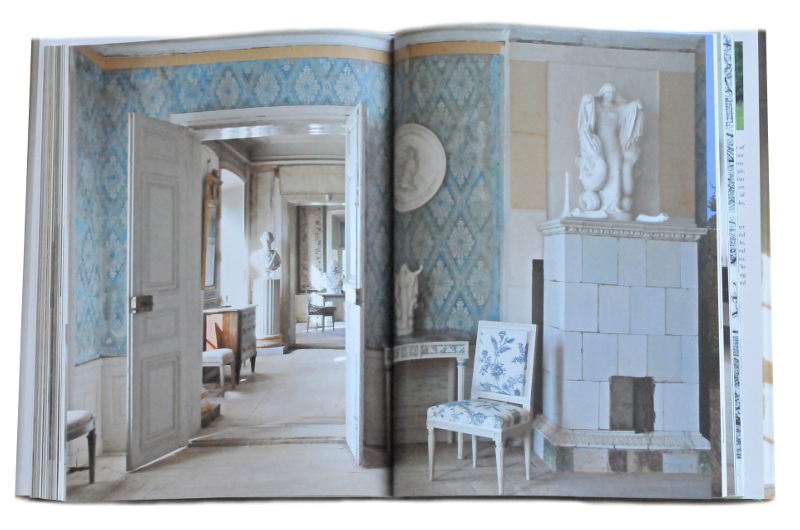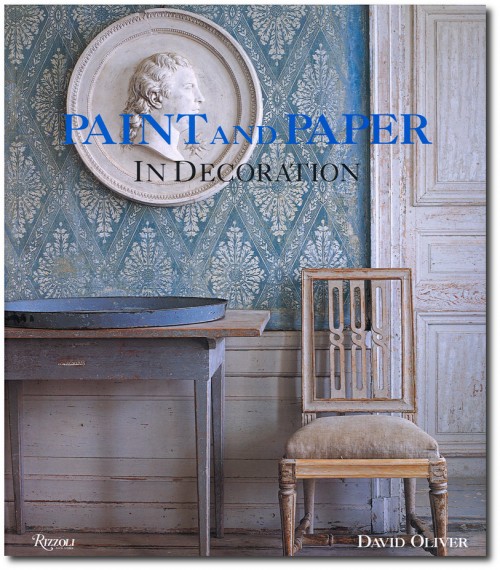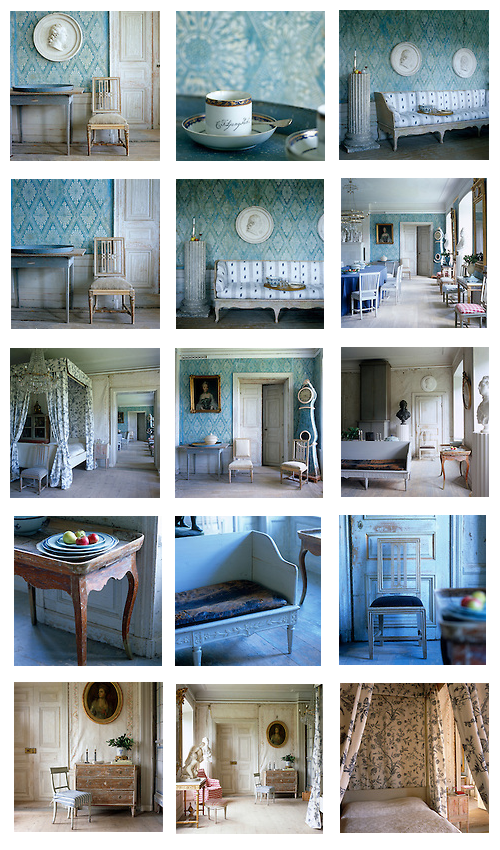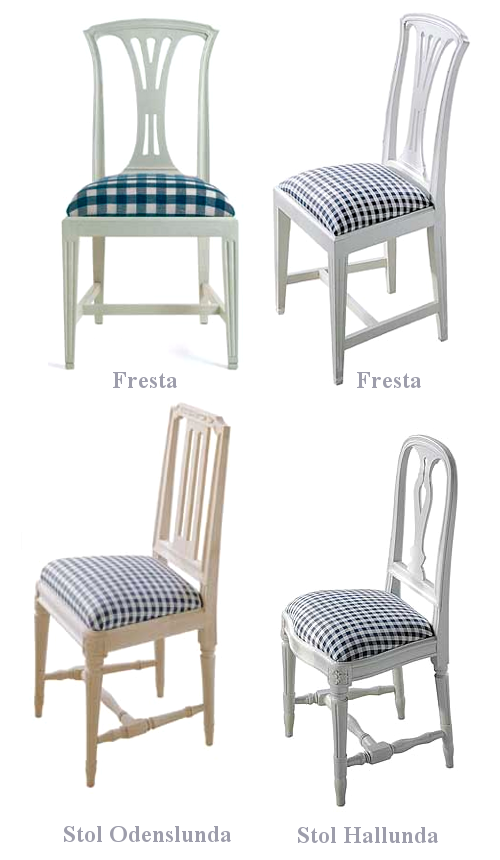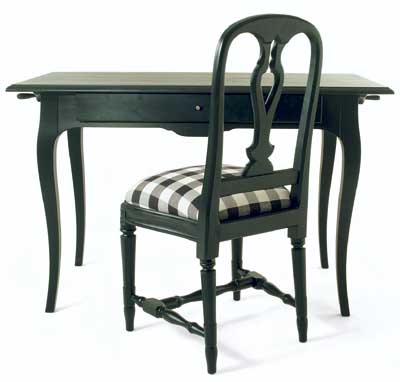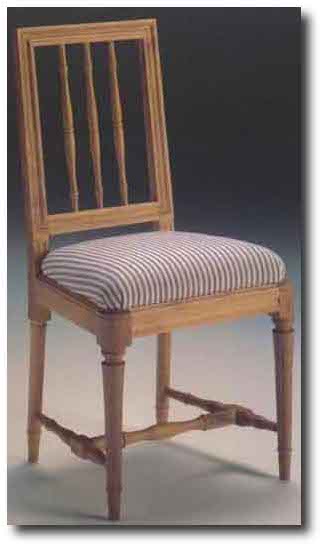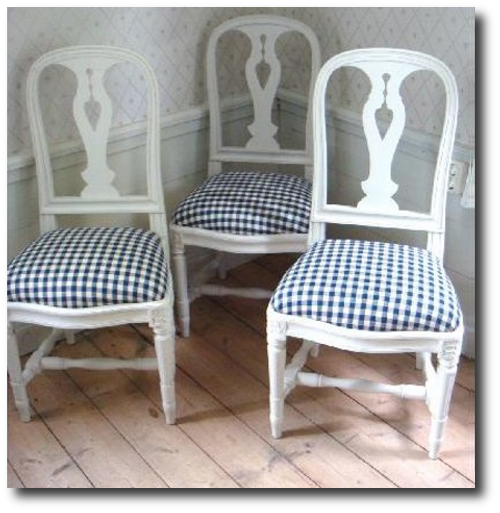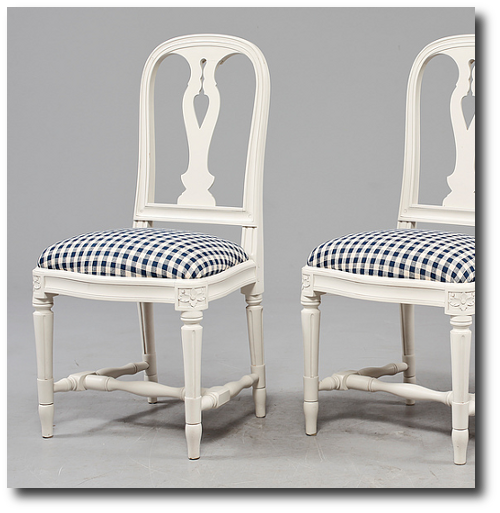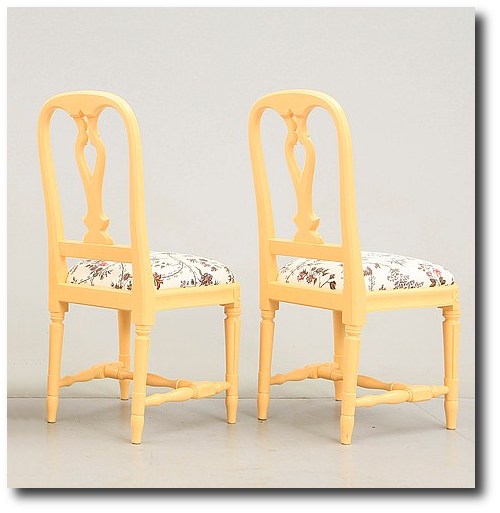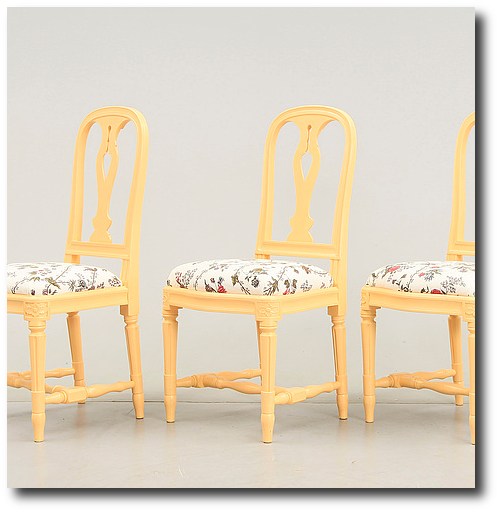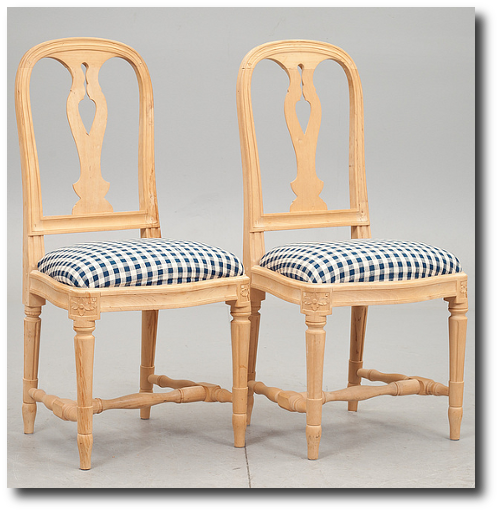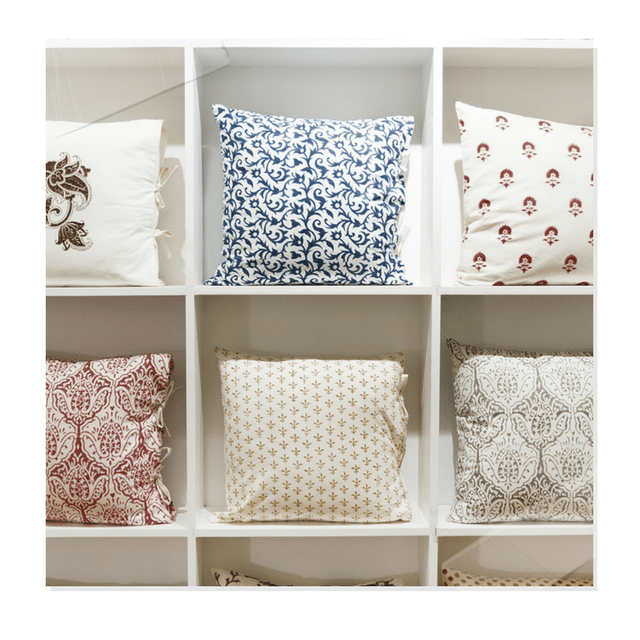
Les Indiennes Fabrics

Mary Mulcahy’s designs, first developed for her block-printed textiles, now grace the wall with the Les Indiennes collection by IVM Prints. The 12 hand-screened wallpapers include Rayure, left, and Veronique, both in indigo; additional colors are offered, Seen in Elle Decor April 2011
The company Les Indiennes is known for their beautiful hand-blocked textiles. Founder, Mary Mulcahy had a desire to find naturally dyed cotton, with large scale single colored motifs, but was unable to locate fabrics close to what she had in mind, so she created her own. Her concept started to take form after running into a craftsman in southern India, who knew exactly what she was after. In fact, the craftsman was one of the very few artists who still practiced the ancient art of kalamkari, which was an extremely complex and rare method of printing on fabric.
The Kalamkari Process:
1. Fabric Preparation- Cotton fabric is initially softened and bleached. This process needs to be done before any printing takes place. The process involves bales of organic cotton which are repeatedly rinsed and beaten against large rocks, then laid out on the grass to bleach in the sun. These steps ensure that the fabric will feel soft and luxurious, and so that the color application remains bright and vibrant.
2. Block Printing- After the fabric has been softened and lightened, printing begins. Craftsmen dip hand-carved wood blocks in dyes and presses them into the cotton. The dyes are derived from plants, roots, earth, and rock. One can only imagine the great care, and measurements taken to ensure the patterns are straight and line up with one another. Today we take for granted large printing machinery, when at one time, much of this work was done by hand. At Les Indiennes, the fabric is printed by hand, and hours go into each fabric panel. After the patterns are applied, the printed fabric is air dried for at least two days.

Decorating Secrets- 60 Quotes From The Best Experts In Design

Swedish winters are long, dark and dreary, so historically Swedes have always turned to lighter interiors. Swedish style isn’t all about the gray and the white interiors they are famous for, but many homes feature brighter, richer colors to decorate around.
There are so many shades and tones of paint, that it can be impossible to decide on one color. Buy sample-size colors to help you make the perfect selection. A color can look quite different at night than the day. We recently painted the outside of our home, and the color which looked to be a creamy yellow at night, turned green in the day. Be sure to try your selected colors on a few different walls to determine what suits which room. You’ll thank yourself for making this extra effort before spending $$$ on the wrong shade.
Don’t judge the room until the paint is in place, and accessories and furniture are placed. A color which may seem to bright can be toned down by wall accessories, coordinating drapes, and art work. Consider working with the off shades of the primary colors. Intead of purple, consider lilac, or a raspberry tint.
Consider whether you are a warm or cool person. I once was asked this by a hairdresser, looking to choose a shade of blonde. I never gave it much thought before, but knowing which color you lean towards can certainly make picking colors a lot easier. Earthy reds, dusty warm plums, and rusty golds are in the warm color range. Silver blues, mint, and lavenders are colors which are cooler.
Advice From Pros
“Design is not just what it looks like and feels like. Design is how it works” Steve Jobs
“Green pigment was expensive in the 18th century, making it a status symbol. So it would have been appropriate for the royal governor’s house. I’ve been a curator at Colonial Williamsburg for 20 years, and when my husband and I lived in a historic house, we had similar green woodwork. It worked with every fabric I wanted to use, and it’s a great mood enhancer—chlorophyll for the spirit!” —Liza Gusler
“People think that they need to use small furniture and light colors to make a small room look big, but that’s not the case at all. Dark colors and just a few pieces of large-scale furniture, with the appropriate lighting and accessories, can give a room a larger, more luxurious feel.” —Mona Hajj
“Everything else in my house is off-white and grey, and I just had to have a break from that. I was looking at my pond, which is this murky shade of acid green, and I thought, ‘I’ll do that in high gloss to make it even more watery and translucent.’ It’s strange, but I love it.” —Stephen Sills
“Luxury must be comfortable, otherwise it is not luxury.” – Coco Chanel
“While looking at one of my first New York apartments, David Hicks told me diplomatically,’Dear boy, if you’re going to paint the walls white, you need art.'” Peter Dunham
“The only time white curtain lining should be used is with white curtains- J Randall Powers
“Use the precious for everyday purposes. We’ll rummage through clients closets and find loads of precious hand-me-downs like porcelain vases and crystal that are a bit out of vogue. We’ll use them for completely ordinary purposes – a case becomes a chic pencil holder, a crystal bowl holds makeup brushes. Turn the ordinary into a special moment” Benjamin Dhong
“I learned that passion about objects and furnishings makes for fearless decorators—and that if you are comfortable in your home, everyone else will be too. That sense of authenticity is what gives a home its soul.”- Courtnay Daniels Haden
“The most elegant interiors are just slightly tatty.” – David Netto
“Playing it safe. Instead, put a large-scale printed fabric or wallpaper on the walls and even the ceiling. It’s easier, safer, and less expensive to be dramatic in a small space. You might get tired of a bold print in the main living area, but it can make a smaller, less-used room an exciting space to spend time.” —Victoria Neale
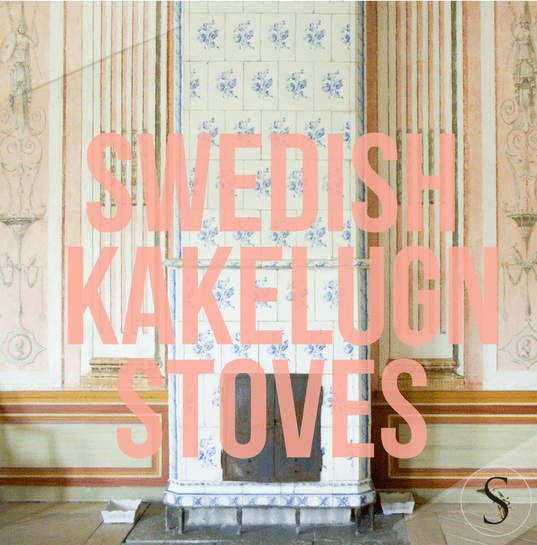
Swedish Kakelugn Stoves
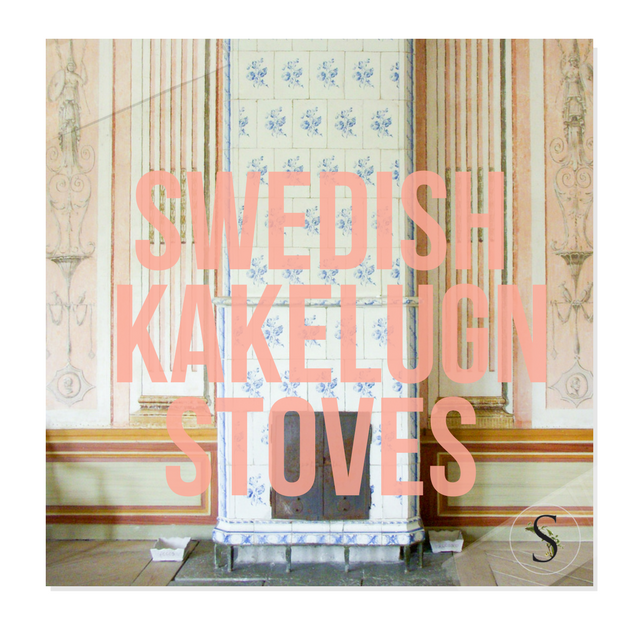
The “Kakelugnar” stove is a Swedish tiled stove whose design is still in use today. This classic stove dates back to the eighteenth century, and adds a historical element to a Scandinavian room. These tile fireplaces usually resemble a column, while the shape is generally very simple. The most popular designs tend to be round or rectangular, and are generally white, and are placed either in corners or against a straight wall. The heights of the stoves range everywhere from six to ten feet or more. The stoves often feature two small folding doors where the wood is placed, and the top of the fireplace forms a crown.
Fire was essential for warmth and food in the Nordic region a century ago. Over time, we have lost some of survival techniques that were passed down through generations. Houses were smaller, and fires were first and foremost placed in the kitchen areas, where the cooking was done. The very first buildings were designed as one large room. An entire family lived in one room, than having many rooms to heat. Today it is fashionable to have vaulted ceilings, and large rooms, but the very opposite was true in throughout history where smaller rooms retained their heat better. Families often slept in the same room to conserve t the warmth, and be near the fire to keep warm through the nights where the temperatures dropped. The earliest homes had no windows, but rather a modest opening to let any smoke out. It wasn’t until the 1600’s when the chimney was invented, and the fireplace was designed to let smoke out of a chimney through the roof.
Above Picture Credit Gullesen Masonry Stoves
The Kakelugn stove’s design first came about when a shortage of wood became a crisis. In an article written by Stone Mason, they describe what prompted the stove design: “The period between 1500 and 1800 was known as ‘Europe’s little ice age’. In Sweden, where it was even colder than it is nowadays, it was clear that the constant use of fireplaces from morning till night would eventually lead to the total depletion of the nation’s forests. It was most fortunate, then, that in 1776 Adolf Frederik, the King of Sweden, commissioned Carl Johan Cronstedt to develop a stove that would make better usage of the country’s timber resources.”
The winters were colder than normal, and the people at this time needed to get as much heat out of the wood as possible. The problem was, too much wood was being consumed, that the government needed to intervene before the forestry was used up. Carl Johan Cronstedt and Fabian Wrede, had received a government mandate to try to find more fuel efficient solutions, and ended up inventing a fuel efficient tiled stove which burned the wood slower, and retained the heat for hours.
The Swedish Kakelugn stoves are a distinguished piece found in the Nordic countries. You won’t find these stoves in Canada, where the winter temperatures are just as cold. During the latter part of the 1800s, the stove found a prominent place in rich mansions and palaces. Beginning around 1830-1840, large farms were being equipped with stoves which soon lead to the countryside and middle class.
Swedish Kakelugnar stoves produced by Swedish Camina, are one of market leaders in Sweden who make stoves. Lindholm Kakelugnar also sells stoves in their original design. Lindolm Kakelugnar, based in Sweden, has been selling and building antique tiled stoves for the past 45 years. The company stocks a range of pieces, including a selection of stoves manufactured from the 1860s to the 1920s, or buy a modernized version from Contura.
The beauty of these classic stoves is that they retain the heat for long periods of time. New modern stoves often heat up fast, but once the flames die out, the stove cools off quickly. The “Kakelugnar” stove burns wood for a period of 1-3 hours, and then provides even heat for several hours after the fire has gone out. In fact, these classic stoves have a better design than the modern day stoves that are produced today.
Read more about the tiled stove visit alltomkakelugnar.se
A Swedish ceramic stove stands in a corner of this panelled boot room
which is decorated with a display of antlers and hunting trophies
Fritz von der Schulenburg, Interior Archive
The Swedish Country House By Susanna Scherman- Buy It On Amazon
Svindersvik Featured On Wikipedia
Kakelugn Stove- Vía: Hus & Hem
A Swedish apartment for sale through Bolaget.

Helen Olsen’s Rungstedlund Home Revealed In Gods & Gardar Magazine

Karen Blixen’s Danish Farm godsochgardar.se
After 17 years in Kenya, Danish author Karen Blixen returned to her childhood home in Rungstedlund, Denmark . The magazine Gods & Gardar reveal the history behind this magnificent property, where Danish elegance meets the drama of Africa.
“It was Karen’s father, Captain and author Wilhelm Dinesen who bought the property in 1879.
Two years later, after his marriage to Ingeborg Westenholz, the couple moved there and had five children, three daughters and two sons. Karen came to stay at Rungstedlund until age 28, except for two periods. The first period was the year the family had to leave Rungstedlund when the farm was restored after a fire in 1898. The second time Karen did Rungstedlund for a long time was when she studied art in Paris.”
“What makes Karen Blixen Rungstedlund so fascinating to visit is that the different rooms reflects two distinct phases of her life. For just as Karen packed some things from Rungstedlund before his trip to Africa, silver candelabras, English porcelain, Bohemian crystal and mahogany furniture, so she brought her most prized possessions, the essence of her Afrikaår, when she moved back to Denmark. On Rungstedlund intermingled memories of Africa still with antique family heirlooms, large carpets, delicate lace curtains, mahogany tables and furniture in the Louis Seize style and a Norwegian Rococo stove from in 1760.”
How To Combine African Elements Into Your Swedish Style
1. Keep the Architecture Nordic.
It is remarkable that Karen Blixen’s home looks both Scandinavian, and African at the same time. How did she pull it off? One of the ways the Scandinavian feel is so clearly evident is in the architecture. The framed walls are one of the hallmarks of the Nordic style. You don’t need several thousand dollars to get this look. One way of doing this is simply by adding some wood trim on the walls. To get Blixen’s look, spray paint your wood trim with gold paint, and finish it off with gold leaf.
Easy Gold Leafing- French Style Authority
Another way of adding architectural detail to your walls is to paint lines in shapes of boxes. A post that clearly shows this idea is Lars Sjoberg’s Swedish Gustavian Decorated House. In this post, you can clearly see lines painted on the walls, which gives the appearance of architectural trim. Where to start? If there is a door in the room, or windows, start with the box above the window or door.
2. Include A Few Moroccan Textures
In the dining area, Karen Blixen uses an area rug with a strong pattern. In this photo, moroccan floor tiles are used to create an entry way. The photo is quite close to Nordic design. A simple white is used on the walls, and the flooring gives this room the edge it needs. The gilt wood mirror gives this room a polished touch. An inexpensive way off adding the pattern into the room is to use throw pillows and tablecloths.
Royal Design Studio sells a moroccan stencil in a star diamond pattern. Consider stenciling your walls in a bright color found in Africa. Consider placing simple painted furniture with this pattern such as white furniture, or black painted furniture. With a white and orange pattern, white furniture can still work quite elegantly. Incorporate pine flooring, and add texture to the walls in natural wood, or metal such as what Karen did with her study.
3. Avoid Clutter.
One of the biggest mistakes people make is have too many accessories. Showcase your art, and draw attention to your furniture by having less accessories, and an open floor space. Even if you jam pack the furniture in, be sure that table tops don’t have dozens of ornaments. Reduce them, pair down, and donate pieces that simply just don’t work with the overall theme.
4. Incorporate The Colors Of Africa
The colors of Africa central around earth tones, such as brown, cream, rich greens, oranges, and reds. For example, you can work with these colors on the walls such Karen did for her home. If the dominant colors are the richer colors, consider toning down the room with a few natural wood pieces. White furniture would provide a rich contrast to the vibrant hues on the walls. If you choose to go with white walls, consider working with painted furniture, or heavily distressed furniture with the richer colors in the upholstery. Can you imagine, raw pine wood floors, with a white settee, gold accents, with burgundy upholstery? Perhaps throw in a rich red chest, and the room can take on the African flavor quickly. To include the Swedish style, pick upholstery fabrics with sweeping vertical lines, stripes or florals, or a combination of both.
6. Create A Wall Collection
Karen’s study is an excellent example of a collection that reflects the African culture. Collect African hand-made pottery, baskets, rugs, swords, plates, knives, but stay away from the masks, or statues which are involved in the ceremonial worship. Woven baskets are an ancient form of art in African culture. Typically crafted with simple geometric designs, African baskets will vary in design, making them great to decorate with.
Space is one of the main considerations when planning a wall based around objects or collections. Avoid a crowded or crammed look when using African wall decor, a little can go a long way. Placing too many items together can look messy, and give the idea that the look isn’t well thought out. Spacing your pieces, or collecting like objects, like a collection of baskets, or knives pays special attention to individual pieces.
Another designer trick is to place even tones together. Working with the color wheel will give you a great idea of the colors to work with, and those to avoid. Try to place the same colors, hues or tones together to give a more organized presentation. Metal, woods, and natural materials work with practically every color, although when working with china, or pottery, it helps to work with the color wheel, when placing items on a painted wall.
Here we see a look of a rich satured green on the walls, with fishing gear displayed
The Scottish Country House by James Knox
 A Swedish tall clock of the Gustavian period which has been professionally scraped to its original blue finish. The movement has been professionally restored and is in working order with both time and strike.
A Swedish tall clock of the Gustavian period which has been professionally scraped to its original blue finish. The movement has been professionally restored and is in working order with both time and strike.
Early 19th Century Painted Swedish Mora Clock- Dated 1827- A Rich Blue Colour which is Original- Beautiful Details
A nice small scaled Danish grandmother’s clock in the 18th century style made during the 1950’s
Swedish Style Traditional Home Magazine
 African Designer Catherine Raphaely
African Designer Catherine Raphaely
Medieval Strong Box Ottoman $406
Floral Bouquet Pedestal Table $185
Medieval Cross Frame Arm Chair$350
Grand Medallion Crescent Console Table $455
African Designer Karen Roos
Camellia Wall Console Table $229
Chateau Marquee Occasional Fabric Arm Chair $588
Mademoiselle Cezanne’s French Slipper Chair $244
The Beaufort End Table $310
African Designer Maira Koutsoudakis
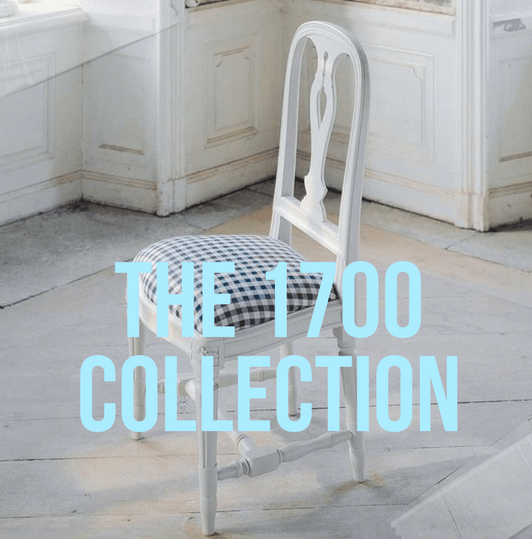
The 1700 Collection Swedish Furniture
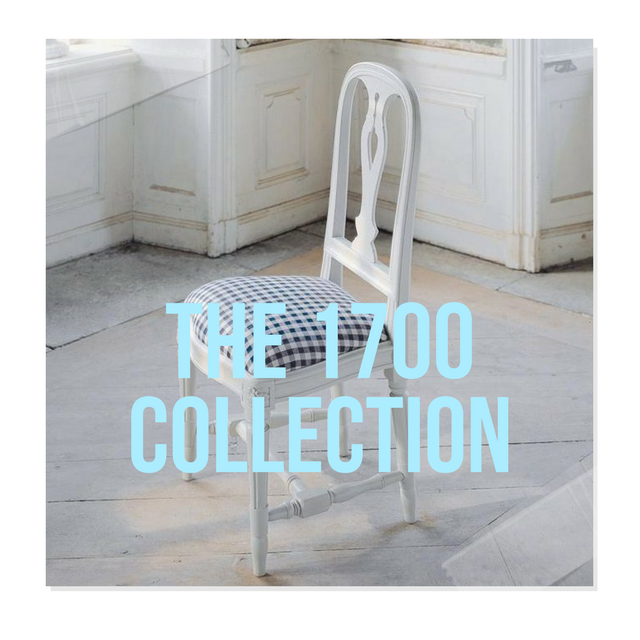
Osterbybruk
The 1700 Collection Swedish Furniture produces furniture that combines the elegant shapes of the furniture found in 18th century Sweden. With the cooperation between the Swedish National Museum of Fine Arts and furniture manufacturer MOVE Möbler & Bohag, they created several authentic replicas of selected pieces of furniture originating from Swedish castles, manors and salons of fashionable health resorts.
The craftsmanship behind each handmade piece remains true to the original. Skilled woodworkers sign each piece next to the seal of the National Museum of Fine Arts. The furniture is made from the woods found in Sweden such as birch, alder and pine.
If you are hoping to purchase a reproduction that is as close to the original antiques, the 1700 collection is deeply rooted in the 18th Century. The collection is a preservation of the Swedish cultural heritage, also giving you an elegant piece of furniture from this era.
Möbler AB
Smyge
Strandv. 71. SE- 231 79 SMYGEHAMN.
Sweden
The 1700 Collection Chairs
Fresta – Stol 1700
Bergslagen
Hallunda – Stol
Medevibrunn – Fåtölj 1700 Collection
Odenslunda – Stol
Sandbro
Medevi
Hellestad
Ekolsund, Selebo
Hallunda
Krogsta
Österbybruk
 The 1700-collection’s Dining Room
The 1700-collection’s Dining Room
The 1700-collection’s Living Room
Svensksund Sofa
The 1700-collection’s Bedroom- Skattmansö
Svensksund Sofa

Swedish Plaster Medallions

Make this bee mold for just dollars. Find the original listing here
Classic Swedish Interiors By Lars Sjoberg
Everyone has their favorite interiors, and one of mine happens to be Ekensberg, a home owned by Lars Sjoberg also featured on the cover of the book Paint And Paper In Decoration . Ekensberg, completed in 1790 is a three-story neo-classical building located on the banks of the Lake Mälaren, about 40 km away from the Swedish capital Stockholm.
Lars Sjoberg is well known in Sweden for the restoration of many cultural sites. Half of all the cultural sites he restored he saved from demolition. His passion for 18th century classical buildings was something he did professionally and outside of work. He invested in a number of classical buildings, in which he restored to the classic 18th style. As a senior director at the National Museum, he was one of Sweden’s leading authorities on Gustavian interiors, architecture, décor, furniture, paints, and everything associated with the reign of King Gustav III. So naturally, all of his homes were restored to the Gustavian style of decoration. This post shows the interior of this home from several angles. His book Classic Swedish Interiors features this home in detail. Interior Archive also gives us a new glimpse into the interior showing many views of this spectacular home.
Here are some of the photos I haven’t seen before.
-Detail of the patterned blue and white fabric of the bed canopy and curtains- here
– An armchair with a red and white gingham cover adds contrast to the otherwise blue and white colour scheme in this elegantly proportioned bedroom- here
– Detail of a distressed wooden tray table used for serving tea here
-To the left of the canopied bed in the master bedroom stands an 18th century dolls’ house-here
– Detail of the end of a wooden sofa with a worn leather seat and carved border- here
– Detail of a wooden chair in front of a distressed wooden door with a bowl of fruit on a tray table in the foreground- here
– View through open double doors into the master bedroom with its canopied four-poster bed here
– The French Directoire wallpaper pattern reflects neoclassical influences from the early 19th century here
-A pair of plaster medallions by Johan Tobias Sergel, a leading Gustavian sculptor, hangs in the dining room- here
-A pair of gilt-framed plaster medallions hangs on the worn walls of the second floor sitting room – here
– A chair in front of a wall lined with hand-painted linen canvas panels and Gustavian plaster medallion- here
Portrait medallions were originally mounted around the public buildings in Stockholm , Sweden. It has been fashionable to use these medallions on the walls inside the home. Portrait medallions in Sweden often are seen round in shape and have a decorative edge much like a round picture frame.
Acquired Objects blog wrote a post showing some of the prettiest plaque pictures which have been seen on Tone on Tone Antiques, Master Henriks Blog, Trouvais Blog and Splendid Willow Blog; all Swedish inspired blogs. They all have great information and exceptional pictures.
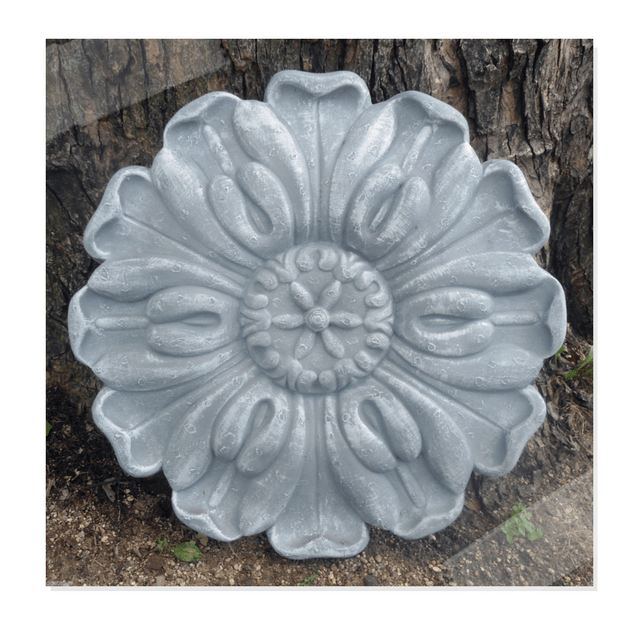
Make your own or sell them….Pastic mold concrete plaster mould $49 on ebay.
This medallion comes from Go Statue on Ebay, You can find the original listing here
Get The Look Yourself
Many of the Swedish Gustavian furniture sites will occasionally have these medallions for sale. Ebay is another place to find wall plaques.
One word of caution, many plaques and busts do feature false gods, so you have to be careful what you purchase and bring into your home. Personally over the years, I have had to throw out many plaques and busts, later to find out they were statues of Roman deities. Before you buy, research what you are buying.
I have found many beautiful plaster plaques with fruit and flowers. The larger medallion molds are harder to find, although you can find some beautiful flower styled plaques on ebay which are quite affordable, and look just as nice.
Instead of one large plaque, consider collecting a series of 9, 18, 27 ect smaller plaques which you can feature on your wall.
Here are some examples:
– Set of 2 metal wall hangings, plaques made in England, Found On Ebay, Pinned to Pinterest
– Vintage Fruit Chalk Ware Apples & Plums, Found On Ebay, Pinned to Pinterest
– Vintage Turner Cameo Wall Plaque, Found On Ebay, Pinned to Pinterest
– 10 inch White Resin Cameo Art Nouveau Head, Found On Ebay, Pinned to Pinterest
– Furniture Appliques From Do It Yourself Chic
Swedish Decorating Gustavian Furniture From Lars Sjoberg
Featured On Tweedland & The Gentlemans Club Blog
Swedish Decorating Gustavian Furniture From Lars Sjoberg
Featured On Tweedland & The Gentlemans Club Blog
My Own Molds, Yaley Round Basket and Flower Molds on Amazon, Judges Plaster Mold Ebay
I had planned on featuring a number of shells on the plain molds, which then can be hung onto a piece of painted wood, or even in an oversized frame. You can even cut out black and white photographs into a circle, which then can be glued onto the the shaped molds that I bought here.
Consider Making Your Own Art
–This article has some amazing inspirational photos of what can be produced with the plastic throw away containers and lids from found at your local bakery. In one photo they create a round plaque possibly from plastic margarine containers. Who knew!
– Mid-century plastic plaques can be antiqued by an application of paint. Simply mix together non-sanded grout and white paint and brush on. This look shouldn’t give away that your plaque is plastic.
– Make Your Own Round 11 Inch Fireman Maltese Cross Cement or Plaster Mold
– 6 3/4″ round Concrete, Baking, Plaster Plaque
– Dogwood Wall Plaques- here, Architectural Plaques, here
– 3 1/2 x 2 7/8 Square Frame Molds. Mount different shells and hang them on the wall.
– Oval Flower Plaque– Make Your Own Chocolate, or gifts with this Swedish looking mold
– Set of 6 Designs For Chocolate or Plaster Molds Here, and Here
– Perfectcast– The professionals choice for casting medium, PerfectCast is five times stronger than any other regular plaster. It is AP Non-Toxic and it reproduces intricate detail identical to the original mold. The only substance you need to add is water. PerfectCast produces a perfect cast every time
Here are a couple resources found around the net:
-A magnificent Gustavian portrait medallion by Sergel , royal sculpture to King Gustav III of Sweden. These medallions were mounted around the public buildings in Stockholm , Sweden. The portrait is of renowned Swedish composer Sergel. It has a steel hook fixed to the back for easy suspension. $785
-A portrait medallion of the famous Swedish Gustavian musician and writer Belmann. This is a museum casting in plaster as the original is in marble and still attached to Stockholm castle. $785 AUD
-This stunning cameo portrait medallion was made by Wedgwood & Bentley c.1777, modeled by William Hackwood. Wedgwood & Bentley was in operation from 1769-1780 preceding Wedgwood. The highly detailed portrait and is applied to a rich solid blue jasper plaque. The portrait is in quite high relief.
-Portrait Medallions – Set of 5 in blue and white jasper. ArtValue.com
-A portrait medallion in plaster of King Gustav III. Reproduced after an original 18th century medallion. –Real Gustavian
-A plaster medallion of Charlotta De Geer of leufsta Manor house Sweden- Real Gustavian
Noteable Links:
-Lars Sjoberg’s Swedish Style- The Swedish Furniture
-Lars Sjöberg and his Swedish manor Ekensberg – Belgian Pearls Blog
– Lars Sjoberg, hero of Swedish Heritage Conservation Tweed And The Gentlemans Club
-Lars Sjöberg Trouvais Blog
-Style I Love: Classic Eighteenth-Century Swedish Interiors- The Style Saloniste
-Decorative plaster – Plaques From www.grandissonstoves.co.uk
-Casting Plaster Plaques-westerntractmission.org
Country Swedish From Veranda Jan 2011
Cecilia Dahlback, owner of Country Swedish, moved to the United States with her parents as a teenager and, after studying international economics and marketing at Georgetown University, discovered that what she really liked was interior design. When the family friends who owned Country Swedish retired, Cecilia saw an opportunity to move into the design business.
The Country Swedish Collection includes a variety of Swedish styled interior furnishings. Their Gustavian reproduction furniture includes a wide selection of chairs, dressers and chests, desks, daybeds, and sofas. Shop some of the finest Swedish wallpaper selections for a quick transformation for that special room in your home.
Gustavian reproductions are made in Scandinavia by craftsmen who continue to preserve the centuries-old traditions of Gustavian Swedish furniture making. The furniture collection begins with beech, birch and pine from Scandinavia. Since most of the pieces are painted, the company has its own paint shop, which guarantees the consistency of the 30 available colors and finishes.
Country Swedish furnishings are sold through designers and architects, but the showroom in Norwalk is open to the public for viewing.

Ekensberg –gal.zhulong.com
Ekensberg, Sweden, late 18th century (Gustaviansk) with some later decoration dating to the early 19th century (Karl Johan), by Lars Sjoberg, Photograph by Ingalill Snitt

